Zwilling Henckels 4-Stage Knife Sharpener In-depth Review
Made by a world-class knifemaker, the Zwilling 4-stage sharpener surprised us with its subpar performance. Here are our test results and in-depth reviews.
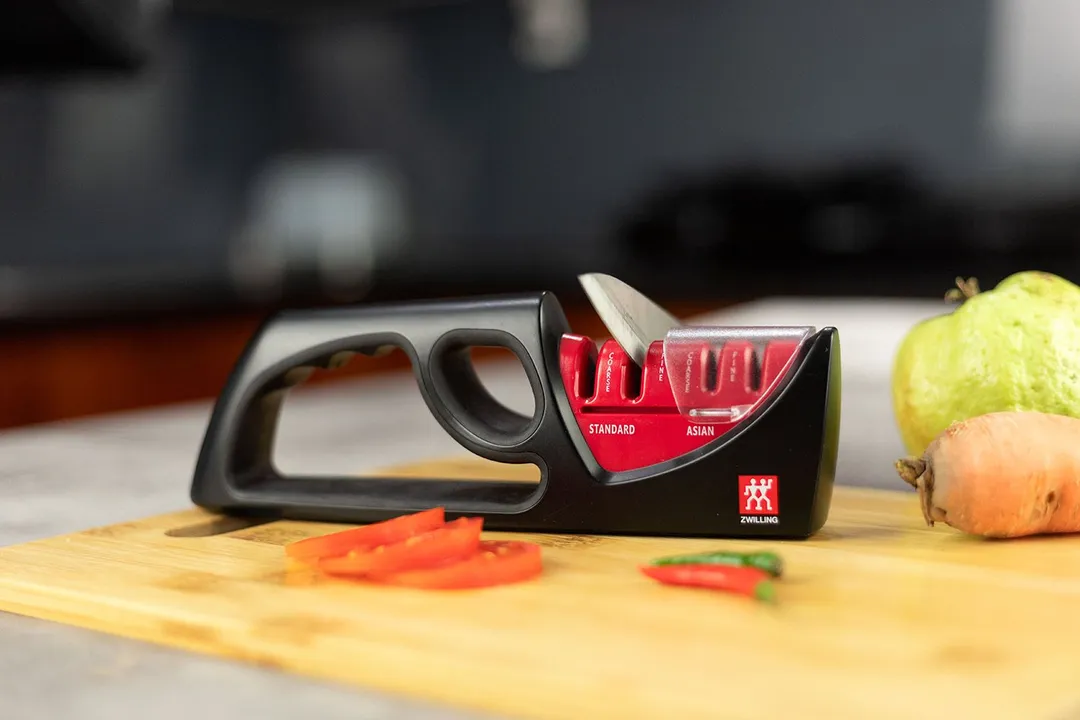
Overall Verdict
The Zwilling 4-stage knife sharpener is more versatile than most, accommodating both Asian and standard knives. However, it offers a lower quality of performance than its robust construction, and price, suggest. It will improve your knife sharpness, but it takes its sweet time, and not without removing a considerable amount of steel from the knife edge. The device is easy to use but only if you have a very firm and steady grip.
Things We Like
- Substantial weight
- Sharpens both Asian and standard knives
- Strong build, high-quality body material
- Slot cover
- Beautiful design
Things We Don’t Like
- Brittle sharpening blades
- Anti-slip pad doesn’t fully cover the base
- Awkward grip
We really wanted the Zwilling knife sharpener to succeed in our tests. For one, it’s from Zwilling, one of the most prestigious knife brands in the world — they must know how to make an effective sharpener. The device seems very well made and certainly looks and feels the upscale price to us.
But there’s more to it than meets the eye, and in the case of the Zwilling, its performance doesn’t quite catch up with its cost or appearance.
Here’s how our experiments with it turned out.
Key Specs
Where to Buy Price at publication $29.53
*You help support HealthyKitchen101's product testing and reviews by purchasing from our retail partners.
Compared to Other Manual Knife Sharpeners
4.7 Performance
The Zwilling isn’t a complete failure: It can sharpen a dead, dull knife to highly serviceable keenness. However, it lost way too many points on speed, which is a critical criterion for convenient sharpeners. Its sharpening blades left a consistent edge, but that doesn’t make up for the excessive amount of material it removed doing so. It reminded us of the Chef’s Choice 4643 in many ways.
1.0 Sharpening Time to Cut a Lemon
The Zwilling is, sadly, one of the slower sharpeners even among its category. It took 180 seconds to sharpen a sandpaper-destroyed knife to the lemon-cutting level, and even then, the cutting motion didn’t feel completely effortless. Three minutes may feel like nothing if you’re used to working with a whetstone, but for a convenient device like this one, one would expect a much shorter time.
7.0 Maximum Sharpness Achieved

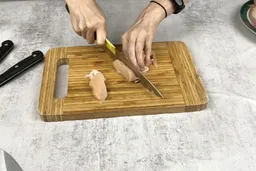
While it failed quite miserably in the speed test, the Zwilling sharpener got decent results when given more time. The test knife passed the tomato test with flying colors and could cut through the muscle and runny skin on a fresh piece of chicken breast with two light and easy swipes.
We tried it on beef tendon too, which it took two heavy strokes to sever. The device was marked as failed for this level, but we think its efforts would be sufficient for most food prep needs.
7.3 Edge Smoothness
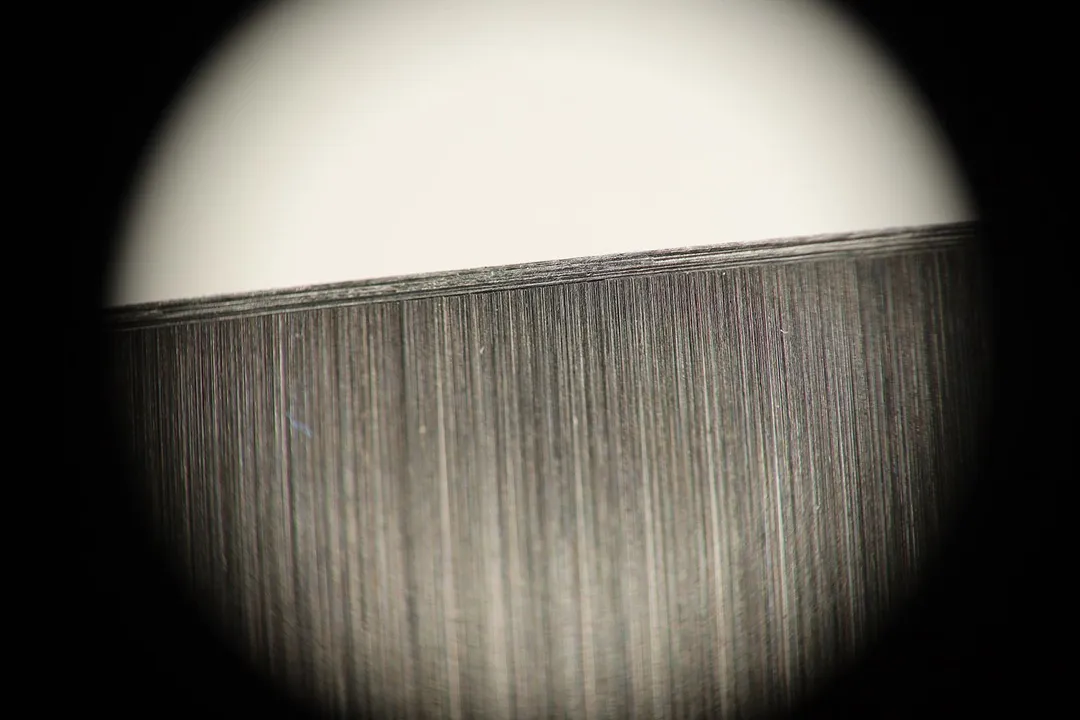
Although the Zwilling peels a lot off the knife, we have to give it credit for the pretty edge it left. There are long and deep grooves along the edge—we could tell from the swarf alone—but overall, the edge is straight and consistent, and without visible chips or teeth.
However, with its ceramic blades chipped after only a few uses, we’re at best skeptical about the device’s ability to maintain delivery of this edge quality.
6.0 Material Retention
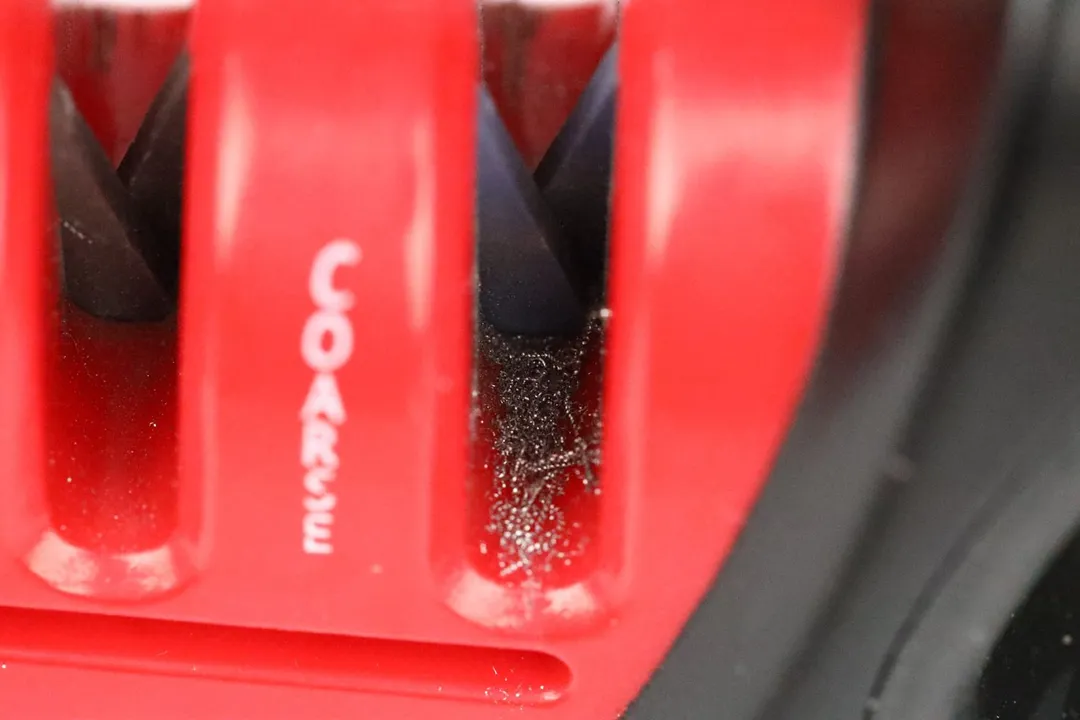

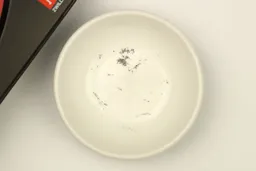
For the sharpness level it could achieve, the Zwilling shaves off way too much steel from the knife. We couldn’t help but shudder at the long curls of swarf coming out of the Coarse slot.
Most other devices employ ceramic rods for honing the knife, so even though this function comes in the form of blades on this sharpener, we really didn’t expect the ceramic to be so harsh on the knife edge.
7.5 Design
The Zwilling sharpener has a robust construction; its frame is made with mostly high-quality materials and has an excellent fit and finish. Its most important components—the sharpening blades—however, seem to be made of the wrong material for the job. The tall, long, but narrow body, meanwhile, makes it more prone to losing balance and stability.
In the Box

- The Zwilling 4-stage sharpener
- Instruction leaflet
The Zwilling 4-stage sharpener comes protected by a plastic blister pack, with a simple instruction manual. The device is solid and heavier than most others.
Dimensions

7.8 Build Quality
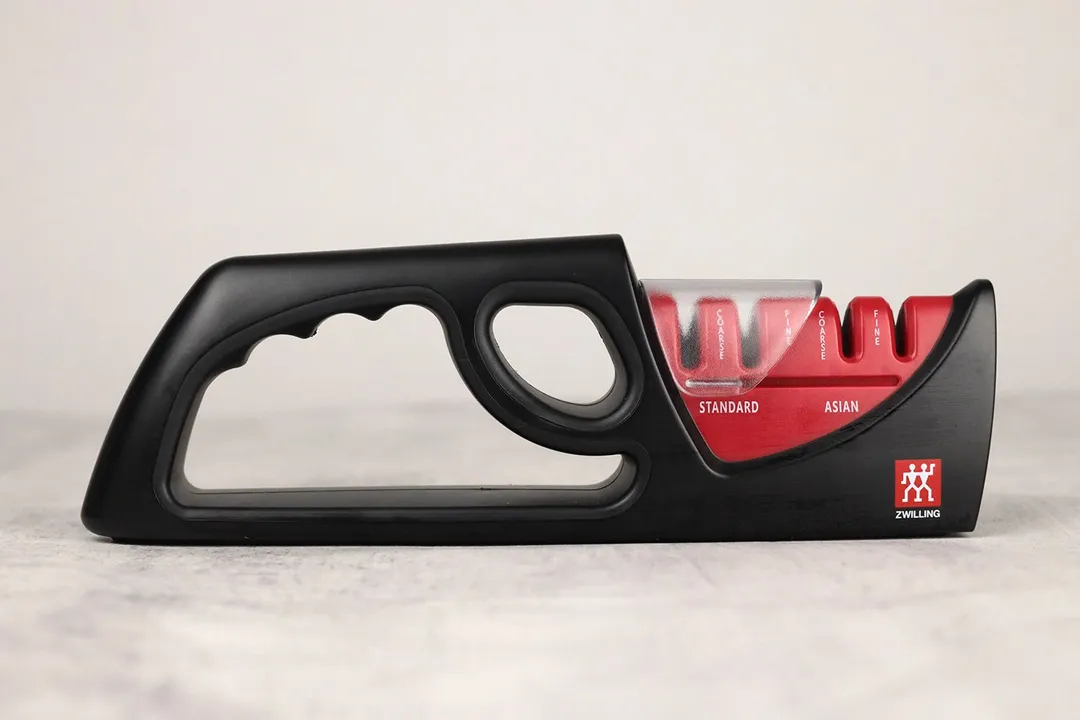
While its design leaves a lot of room for improvement, the Zwilling is overall a robust, well-built sharpener. Its body feels rigid and solid, the frame and paddings are made of high-quality materials, and every part fits together nicely, leaving no gaps.
Unfortunately, the device’s weakness is its most critical part: the ceramic sharpening blades.
Normally, ceramic is used to make honing rods on pull-through sharpeners, but on the Zwilling, it’s employed in the shape of rectangular sharpening blades with their own delicate edges. The chipping we found on those blades after only a few days of testing proved that this break from the norm was an error of judgment. Obviously, being hard but brittle, the ceramic blades couldn’t withstand a rough steel knife edge.
6.5 Grip
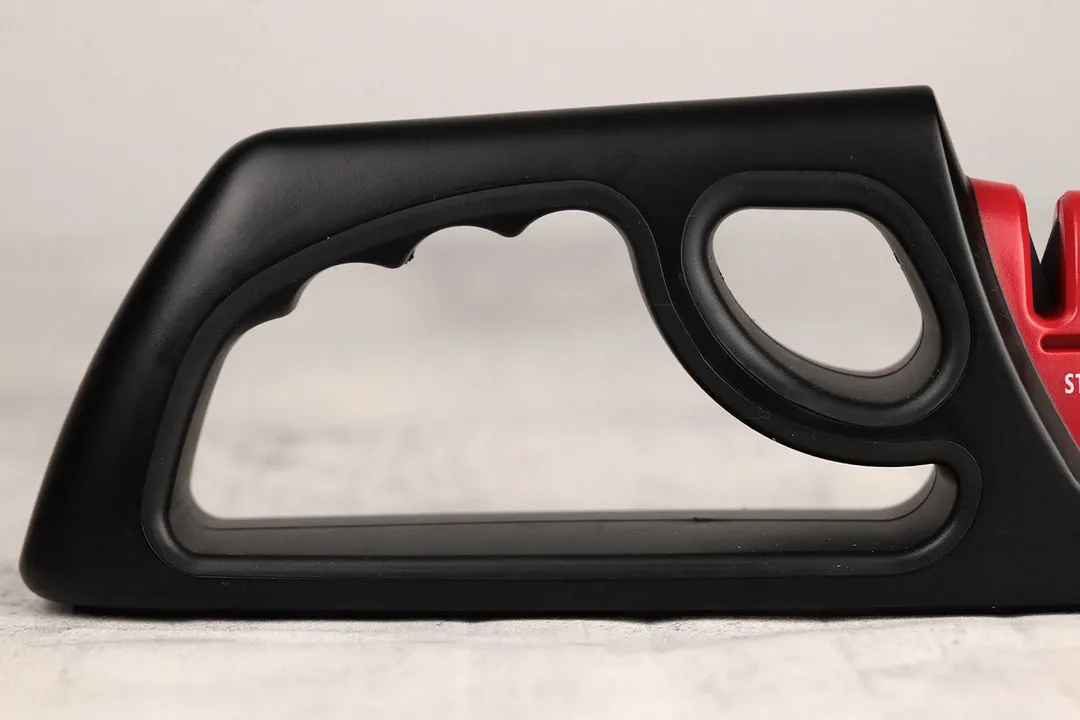

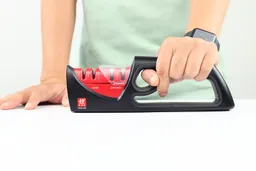
The Zwilling’s grip looks and feels fancier than most other devices’, but we wish the design were more simple. The thumb holder was awkward to grasp, and both of us testers couldn’t seem to align our fingers with the finger nubs.
We also thought the space between the grip and the base to be excessive — a lower height and center of gravity would immensely improve the device’s stability.
Working Section

The Zwilling sharpener has a long working section, covering two types of edge angle: standard and Asian. We find the alleged grind angles of 15 and 10 degrees to be surprisingly small—standard knives typically come at 18-22 degrees and Asian knives, 13 - 15 degrees. An edge angle of 10 degrees is probably more appropriate for razors than kitchen knives.
Angles aside, we like how the working section is closer to the base than the rest of the device is. This helps lower the center of gravity even only by a little, and improves the overall balance.
Base



The Zwilling sharpener has a solid, flat base, with a high-quality anti-slip pad underneath. But this is yet another area where it suffers from bad design.
The base is long and narrow, which is not ideal for its considerable height. The pad only partially covers the base, leaving its border hanging in the air— the pad basically adds height while further reducing the already modest width. As a result, the device is very prone to rocking.
8.2 Ease of Use
Though the Zwilling’s slot layout is not exactly basic, it’s easy to work with. Blade insertion is safe and simple. However, the actual sharpening process can be a little challenging as the device tends to rock on its narrow base pad.
10 Slot Arrangement

The Zwilling has more sharpening slots than most others, but its layout is straightforward. Half of the working section is for standard blades and the other half Asian, as indicated by the print underneath. The slots progress in the same order for each angle type, with their coarseness level printed on their sides.
A transparent plastic cover can be slid over the area you’re not working on, so it’s rare that you will misplace your knife while sharpening.
9.0 Insertion

It doesn’t have the widest slot openings, but insertion is still effortless with the Zwilling. Its lowered working section and the rather spacious grip do offer a sense of confidence and safety in this regard.
7.5 Pulling Through

The problem with abrasive blades is that sometimes they lose grip of the knife edge, letting it glide through untouched. The fact that its blades are made of ceramic instead of tungsten carbide as a typical sharpener’s would be doesn’t exempt the Zwilling from this issue.
The thick frame around the slots, while offering great support, does obstruct the knife tip at the end as the downward force is still in place. It gets nicked from time to time, though this doesn’t affect the knife edge or sharpness.
7.5 Stability on a Clean Surface
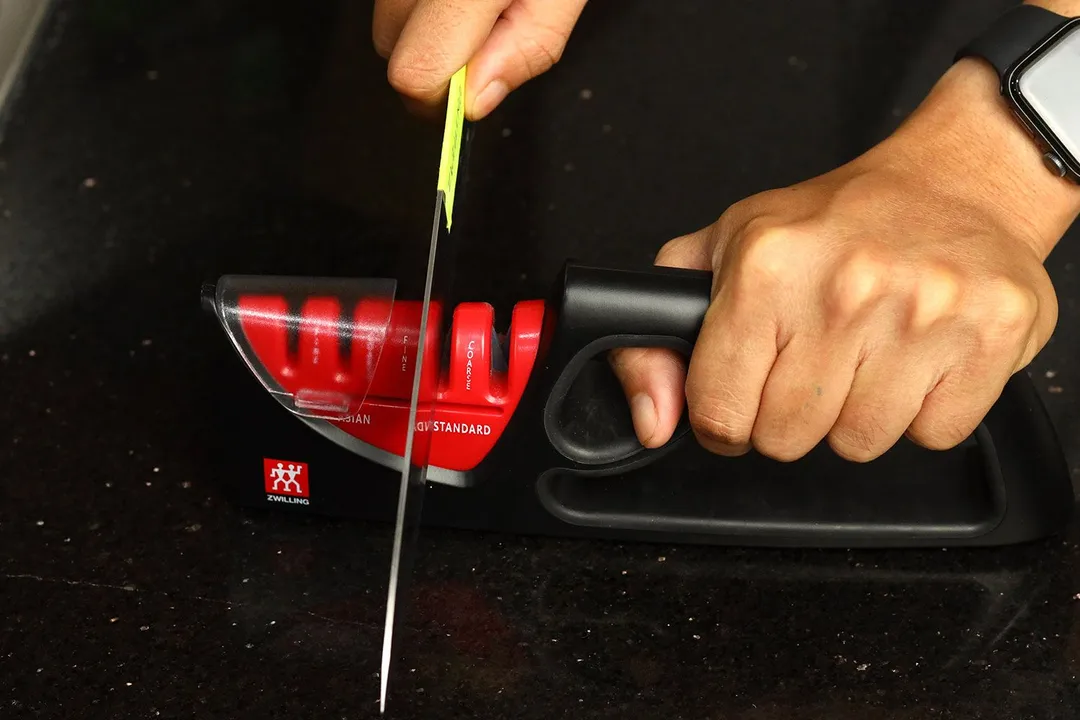
The Zwilling’s heavy weight (a whopping 11 ounces) and solidness couldn’t cancel out the effect of its massive height to stabilize the device. Nor did its narrow base and an even narrower anti-slip pad allow it to fare well in our test. The sharpener kept losing its balance.
6.0 Stability on a Wet and Dirty Surface
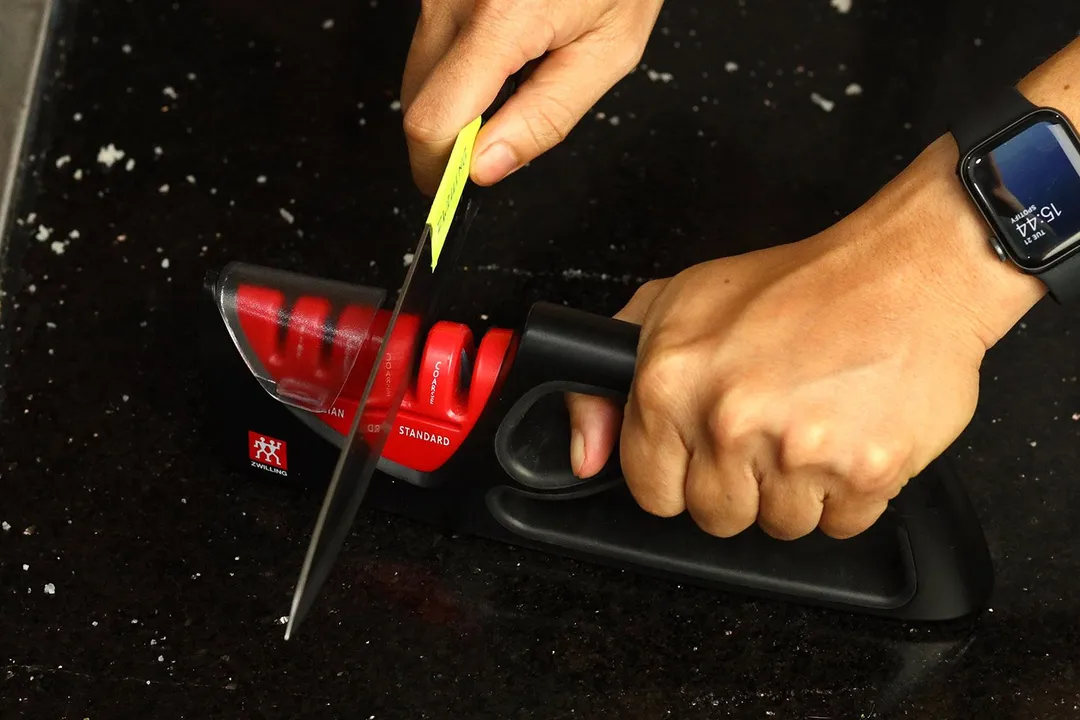
The oil- and salt-tainted countertop only amplified all the design problems on the Zwilling. We could only keep it in place with excessive force on the grip, and so we highly recommend ensuring your countertop is dry and clean before using this sharpener.
Behind the review
Anh Ngo is a writer with 9 years experience at different media outlets, covering from public news and events to product testing and analysis. At HealthyKitchen101, she works across different departments, communicating closely with its network of writers, editors, and health, tech, and search engine experts to provide a meaningful and pleasant reading experience for visitors.
Lap is Head of the Research, Testing, and Review Team (RTR Team) at HealthyKitchen101.com, where he directs and supervises the testing of kitchen gadgets and appliances.
Nguyen Ntk is a graphic designer, photographer, and videographer whose philosophy centers around respecting and celebrating the beauty of reality. Through his lenses, Nguyen strives to capture the true essence of objects and events, showcasing and highlighting authentic features without distortion or exaggeration.


